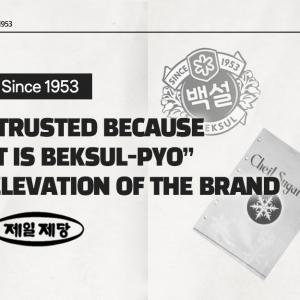
A New Player in the World of Cooking Oil
The 1960s was a significant period for Korea’s economic growth, with notable increase in national income leading to changes in dietary habits. Before the 1960s, cooking oil was usually made from sesame and perilla seeds, with a common alternative being rice bran oil, which was readily available commercially. However, since the 1960s, the demand for affordable soybean oil started to increase, prompting CheilJedang to consider entering the soybean oil market in 1967.
The soybean processing business – which involves both the production of soybean oil and formulated feed mixture for livestock – presented an opportunity for CheilJedang to grow itself into a comprehensive food company. By 1978, the company was undergoing growth across all sectors of its business, including the seasoning business, CheilJedang used this momentum to embark on full-scale soybean processing.

First, CheilJedang purchased a factory site in Incheon City measuring approximately 609,600 square meters. The site was chosen for its proximity to Seoul, where CheilJedang’s biggest customer base was, and for the nearby port, which could facilitate raw material transportation. From the outset, CheilJedang founder Lee Byung-chull was said to have high expectations for the company’s soybean-processing endeavors.
Till the very first successful shipping was made, there were challenges involved in constructing the new factory on the stretch of desolate west coast tidal flats and manufacturing -a small hole in a pipe caused issues during the refining process, while the insufficient water content resulted in the discoloring of the oil.
Despite these obstacles, CheilJedang’s ‘Beksul-pyo Cooking Oil’ launch day finally arrived. On September 6, 1979, a banner celebrating the commencement of shipments was hung from the product warehouse, with cheers erupting from the assembled workforce. They had struck soybean oil.

“A Clean and Savory Taste”
Following sugar, flour, seasoning and feed, Beksul-pyo Cooking Oil was the fifth product CheilJedang rolled out to its customers.. The new consumer climate brought about by the developing Korean economy meant customers were more discerning than ever about quality in food manufacturing. On top of this, the market was saturated with competitor companies that held sway over a 90% share of the market.
CheilJedang collected feedback from its main target- 1,500 housewives living in Seoul and used the insights to develop their new Beksul-pyo offering.
To make their product more appealing to their target customer base, CheilJedang used transparent containers that allowed consumers to examine the oil closely and introduced double caps to make it easier to control the amount of oil dispensed when pouring. While features like this are standard now, at the time they were welcome innovations.

The results were a significant success. At sample tasting corners, enthusiastic housewives crowded around to try the new product. Boasting high-quality ingredients and a “clean, savory taste,” Beksul-pyo Cooking Oil was a hit with customers.
By 1984, CheilJedang’s market share for household products and soybean oil had reached 37% in just five years, a remarkable achievement. The company also increased the strength of its PET containers to prevent breakage and ensure the oil was well sealed against the outside air to avoid product deterioration. Through steady improvements like this, CheilJedang’s cooking oil and its other household products won the trust of customers nationwide and became more competitive than ever.
In 1987, CheilJedang launched a new product: ‘Beksul-pyo Sesame Oil.’ At the time, counterfeit sesame oils were causing widespread distrust of oil products among customers. However, thanks to its reputation for brand safety and integrity, Beksul-pyo Sesame Oil enjoyed an overwhelmingly positive consumer response. As a result, the number of Beksul-pyo oil distributors grew from 85 to 100.
Beksul Olive Oil: A New Sensation in the Premium Oil Market

In 2005, CheilJedang ultimately emerged as the leader in the cooking oil market, at one point recording a market share of 42% and exceeding all its competitors. Thanks to the company’s focus on product development, ongoing container and packaging innovation and a customer-centered approach, Korea had a new cooking oil market leader.
Beksul Becomes the No.1 Household Cooking Oil in Korea

By 2010, CheilJedang had cemented its position as the dominant brand in the household cooking oil market and had expanded its lineup. According to a market survey conducted by Nielsen Korea, it ranked first in all cooking oil categories, including soybean oil, corn oil, olive oil, grape seed oil and canola oil. In the context of the highly competitive Korean cooking oil market, this was no small achievement.
Central to CheilJedang’s success was its commitment to high quality. The company sourced premium raw materials for grape seed oil and olive oil and subjected them to double safety inspections at the CJ Food Research Institute. Its soybean oil was made with 100% Korean soybeans, helping it stand out against the competition and guaranteeing clear, clean, five times-filtered cooking oil. In February 2016, cumulative sales for Beksul Canola Oil exceeded 100 million bottles for the first time.
To this day, CJ CheilJedang continues to respond actively to consumer feedback and adopt eco-friendly practices. The company has reduced plastic usage in its Beksul cooking oil products by employing containers with lighter packaging. Additionally, transparent plastic bottles and easily removable labels have been introduced for easy recycling.



